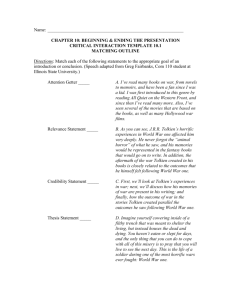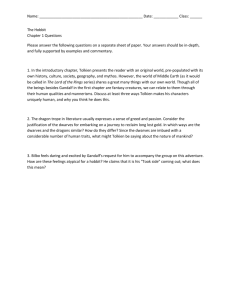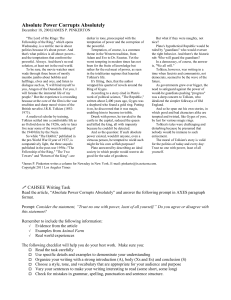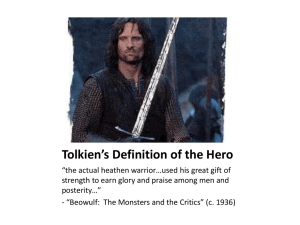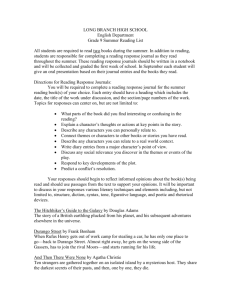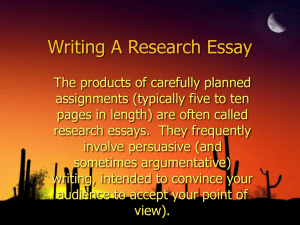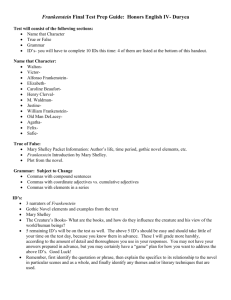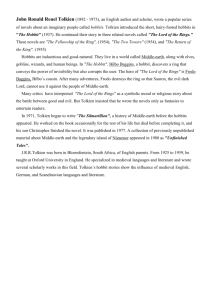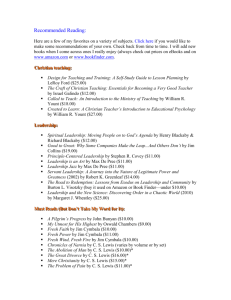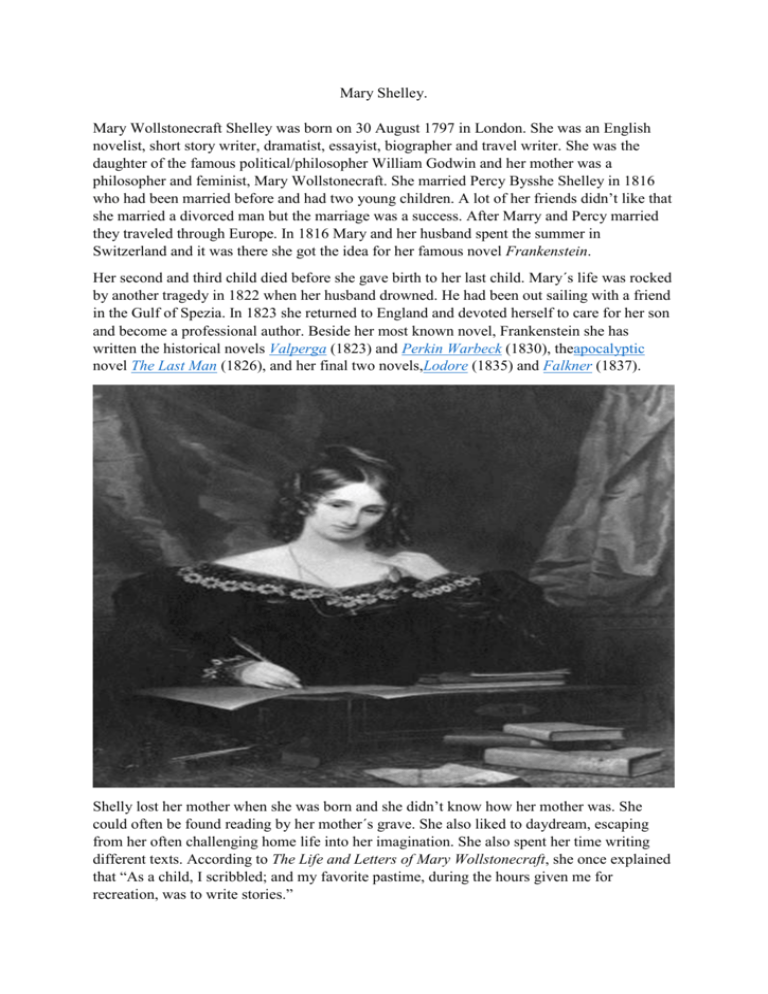
Mary Shelley.
Mary Wollstonecraft Shelley was born on 30 August 1797 in London. She was an English
novelist, short story writer, dramatist, essayist, biographer and travel writer. She was the
daughter of the famous political/philosopher William Godwin and her mother was a
philosopher and feminist, Mary Wollstonecraft. She married Percy Bysshe Shelley in 1816
who had been married before and had two young children. A lot of her friends didn’t like that
she married a divorced man but the marriage was a success. After Marry and Percy married
they traveled through Europe. In 1816 Mary and her husband spent the summer in
Switzerland and it was there she got the idea for her famous novel Frankenstein.
Her second and third child died before she gave birth to her last child. Mary´s life was rocked
by another tragedy in 1822 when her husband drowned. He had been out sailing with a friend
in the Gulf of Spezia. In 1823 she returned to England and devoted herself to care for her son
and become a professional author. Beside her most known novel, Frankenstein she has
written the historical novels Valperga (1823) and Perkin Warbeck (1830), theapocalyptic
novel The Last Man (1826), and her final two novels,Lodore (1835) and Falkner (1837).
Shelly lost her mother when she was born and she didn’t know how her mother was. She
could often be found reading by her mother´s grave. She also liked to daydream, escaping
from her often challenging home life into her imagination. She also spent her time writing
different texts. According to The Life and Letters of Mary Wollstonecraft, she once explained
that “As a child, I scribbled; and my favorite pastime, during the hours given me for
recreation, was to write stories.”
At the age of 24, Mary Shelly worked hard and she wrote several novels, including Valperga
and the science fiction tale The Last Man (1826). She also tried to promote her husband´s
poetry and preserve his place in literary history.
Marry Shelly died of brain cancer on February 1, 1851, at the age of 53, in London, England.
She was buried at St. Peter's Church in Bournemouth, laid to rest alongside her father and
mother and with the cremated remains of her late husband's heart.
How she wrote:
Her father encouraged her writing talent and she that should continue writing. He taught
Mary how to make some nice letters and she got really good at writing them. Writing was her
favorite thing to do in her spare time. Everything she had written disappeared in 1814 when
Percy Shelley and Mary escaped, none of her remaining manuscripts are dated before this
year. Her first published work was Mounseer Nongtongpaw which is some comic verses
meant for Godwin’s Juvenile Library when she was ten and a half. Her poem didn't have her
name, she wrote that one under a different name in the latest collection edition of her works.
Autobiographical element:
Some parts of her novels are often interpreted as disguised paraphrases of her life. Critics
have particularly pointed to the recurrent father-daughter scene as evidence of this
autobiographical style. An example of this is the most common interpretation of Matilda
(1820) in which the three characters are identified as Mary Shelley, William Godwin and
Percy Shelley. Mary Shelley admitted that she based her main characters in The Last Man on
her Italian circle.
Novel genre:
Mary Shelley used the techniques drawn from many novel genres, particularly from Godwin's
novels, Walter Scott's new historical novel and the gothic novel. Frankenstein explores many
of the themes and stylistic artifice found in Godwin's novel, but Mary Shelley criticizes the
Enlightenment ideals that Godwin exalts in his works. Mary Shelley uses the historical novel
shape to comment on gender relations. In Shelley's other historical novel, Perkin Warbeck ,
symbolizes Lady Gordon values like friendship , family life and gender equality. Through
her, Shelley offers a feminist alternative to the male power politics that destroy the male main
character. The novel challenges the historical narrative sense that Shelley's novel is a
historical narrative that includes, events relating to the world of men.
The fact that it became common to conduct literary criticism from a feminist perspective in
the 1970s made Mary Shelley's works, particularly Frankenstein , attracting more attention
among academics.
Frankenstein
Frankenstein , like many other gothic novels from the period mix renunciation of the objects
of speculative and provocative themes. Rather than focusing on all the twists and turns in the
story underlines the main character's mental and moral struggle. Shelley fills the text with
their own form of politicized romance, one that is critical of the traditional Romantic
individualism and egoism
Frankenstein is basically about the contradictions between natural and unnatural reproduction
. " Victor Frankenstein's failure as the" parent " of the novel has been interpreted as an
expression of the anxiety associated with pregnancy, childbirth and motherhood.
Medical student Victor Frankenstein gets in touch with a man who has managed to re- create
life from dead matter and becomes obsessed with the idea. By sowing pieces of body parts
together, he creates a man who comes to life . The monster escapes and learns to speak and
read, hidden in an outbuilding. He becomes increasingly angrier against humanity and
promises to take revenge on Frankenstein.
Victor Frankenstein goes to Ingolstadt to study. Once there, he gets stuck to the natural
sciences and especially to chemistry. He reads all the books he could come across and goes to
all lectures on the subject. In the end, the one thing that interests him the most is the body's
structure and the origin of life's principles. He studies anatomy and takes an interest in death
to thus obtain answers about the origins of life. Then he gets in touch with a man who has
managed to re- create life from dead matter and becomes obsessed with the idea. After some
time, he finds that he is inclined to give life to inanimate objects and decides to create his
own creature from dead matter. This turns out to be not too successful. Frankenstein does not
consider what the consequences of his actions could be and when the monster finally become
alive Frankenstein is so excited by this fact that he flees the scene. When he comes back the
monster is gone. The monster then walks about alone and tries to get to know the people and
their habits. But his appearance scares people he met, therefore, with hatred he turns back. He
wants to get great revenge and chooses to direct it towards his creator, Frankenstein.
Sources
·
Shelley, Mary. Collected Tales and Stories. Ed. Charles E. Robinson. Baltimore: Johns
Hopkins University Press, 1976. ISBN 0-8018-1706-4.
Shelley, Mary. Frankenstein; or, The Modern Prometheus. Ed. Susan J. Wolfson. New York:
Pearson Longman, 2007. ISBN 0-321-39953-6.
https://sv.wikipedia.org/wiki/Mary_Shelley#Sj.C3.A4lvbiografiska_element
https://sv.wikipedia.org/wiki/Frankenstein_(film,_1994)
Questions
1.
2.
3.
4.
5.
How did Mary Shelly get the idea to write Frankenstein?
Name three novels she was written?
How and when did Mary Shelley die?
In which book did she base her main characters on her Italian circle?
Where did Frankenstein go to study?
J.R.R Tolkien – Creator of Lord of the Rings
Short Introduction:
Tolkien was born January 3rd, 1892 in Bloemfontein, Orange Free State, South Africa. Tolkien died
the 2nd of September 1973 in Great Brittan. His and his wife Edith’s graves lie in Wolvercote
Cemetery, Oxford. His full name: John Ronald Reuel Tolkien. J.R.R. Tolkien was en English writer,
poet, philologist and university professor. J.R.R. Tolkien is most famous for being the author of the
Hobbit, The Lord of the Rings and The Silmarillion, which are all works of the genre classic highfantasy. Tolkien also served in the Great War (WW1) from 1915 ‘til 1920 and fought in the battle of
the Somme. Tolkien was very interested in linguistics; he created the language Elvish, which you can
go and take courses in and learn how to speak.
Tolkien’s Life:
J.R.R Tolkien’s early life started in South Africa with his parents Mable Tolkien and Arthur Reuel
Tolkien, who was an English bank manager. 1894 on the 17th of February Hilary Arthur Reuel,
younger brother to J.R.R. Tolkien, was born. At the age of three J.R.R. Tolkien went to England with
his mother and brother to stay there for a lengthy family visit. But life changed drastically when
J.R.R. Tolkien’s Father died of rheumatic fever back in South Africa before he could come to England.
Without any kind of income, mother Mable had to take her children and live with her parents in
Kings Heath, Birmingham. Later J.R.R. Tolkien moved with his mother and brother to Worcestershire
village. There he enjoyed exploring different places: Sarehole Mill, Moseley Bog, the Clent, Lickey
and Marvern Hills. All these places would later inspire scenes in his literature.
J.R.R. Tolkien was home schooled and had his mother as his teacher. His favorite subjects were
those that concerned language. Later in 1904 when Tolkien was 12 years of age, his mother died of
acute diabetes in Rendal. Before Mabel Tolkien died she had her sons assigned the guardianship of a
close friend, Fr. Francis Xavier Morgan of the Birmingham Oratory. After this incident Tolkien moved
to the Edgbaston area of Birmingham and started attending King Edward’s School and later St.
Philip’s School. When studying in King Edward’s School, Tolkien made three close friends: Rob
Gilson, Geoffrey Bache Smith and Christopher Wiseman. The group of four created the Tea Club and
Barrovian Society where they drank tea and later wrote poetry during a reunion. Later during the
Great War both Geoffrey Bache Smith and Rob Gilson perished in the battle of the Somme in France.
In 1908 when J.R.R. Tolkien was 16, he moved into a boarding house in Duchess Road where he
met Edith Mary Bratt, who became his wife: Edith Tolkien. Edith was 3 years older than him and a
protestant, while J.R.R. Tolkien was Catholic. Tolkien’s surrogate Father Francis prohibited him from
having any kind of contact with Edith until he was 21. If Tolkien was found to have been in contact
with Edith, Francis threatened him with ending his university career. With this, Tolkien was forced to
accept and follow the heartbreaking order. On the day of his 21 birthday, however, he wrote a letter
to Edith explaining his circumstances and that he had never stopped loving her and he asked her to
marry him. She responded with that she had accepted a proposal of George Field, but she had only
agreed to this proposal because she felt alone and doubted that Tolkien still cared for her, but with
receiving Tolkien’s letter she told him that everything had changed and said yes to marrying him
instead and sent back the proposal ring to George. Edith and Tolkien married in 1916 on the 22nd of
March.
On the 2nd of June Tolkien was summoned to Folkestone to be transported to France to join the
battle. A month later he arrived in Somme, France, where he participated on the attack of Schwaben
Redoubt and the Leipzig salient both German posts. Tolkien might have died in the trenches, but
luckily in the unlucky situations, he became ill with so called trench fever and had been removed
from the battle field, while almost all of his battalion had perished. After the war Tolkien started
working at the Oxford English Dictionary.
Literature:
During his career Tolkien worked with traditional English literature such as Beowulf and Sir Gawin
and the Green Knight, No doubt these works influenced his authorship along with his experiences of
the Great War. On the one hand many of the characters show how common Britons were dragged in
the epic conflicts between good and evil just as the same way the Hobbits were forced in fighting
epic battles between good and evil. In Tolkien’s version simple people of Middle Earth rose to the
occasion and conquered unimaginable evil as embodied by Lord Sauron and his ring.
On the other hand, the symbol of the ring ties in with the sagas of the Nibelungenlied, which is the
original German version of the Norse Gods. Tolkien takes advantage of the idea of a ring that can
affect its own fate. In his literature his main focus is the epic battle between Good and Evil, however
he sets battle on a stage of mythic proportion with Orcs, Elves, Dwarfs, Ents, Wizards and Hobbits
etcetera. These characters together create a new mythology for the English. A concrete example of
Tolkien’s use of ancient myth is naming “famous” swords in his sagas. Just as in the ancient
Arthurian Legends where the King’s sword has the name Excalibur so does Gandalf’s sword have a
name: Glamdring.
Something that should not be forgotten is that Tolkien mainly used English words with Germanic
origins, that is to say, he avoided using words of Latin or French source. Not only that an example of
his example of his excellent knowledge of the English language but also reinforces the authenticity of
his texts. It was indeed a new mythology for the English people.
To summarize his main goals with his literature he focused on what common Briton could achieve
if they set their mind to it. Tolkien built on well-known mythic tales that everyone could relate to
and uses a language that was distinctly English. Even though we meet hardships, if we put enough
effort in to it we can subdue evil (Gollum being the notable exemption; he gave in to the evil of the
One Ring). Frodo who inherited the Evil Ring proved to be strong enough to destroy it with Sam’s
help. Tolkien’s second goal was to recreate English mythical literature which he succeeded in doing
with classic High-Fantasy style of writing. Finally using a strictly English, Germanic or Norse
vocabulary, Tolkien redefined how the English language was used.
Question to the reader:
If you’re familiar with Tolkien’s authorship, The Hobbit and The Lord of the Rings trilogy, can you
think of any other similarity with ancient mythology?
C.S. Lewis
One of the world’s most known writers in the world is C.S. Lewis, but his full name is Clive
Staples Lewis. He was born on the 29th of November 1898 in Belfast, Ireland, and died on the
22th of November 1963 in Oxford, England. C.S. Lewis was not stuck with just one genre
throughout his life, but he wrote in several areas in the British and Irish literature. He was a
British/Irish novelist, a poet, an academic and most of all a Christian apologist.
During his time, he has gone between being a believer in Christianity, to being an atheist and
then starting to believe again, which has led to a number of his works being influenced by his
faithful self.
He had a small family consisting of his father Albert James Lewis, a solicitor, his mother
Florence Augusta Lewis, also called Flora and his older brother Warren Hamilton Lewis. His
mother died from cancer when he was only 10 years old.
When he and his brother were younger they had a dog called Jacksie. When Jacksie died
Lewis announced that his name was now Jacksie. When he got a few years older he then
accepted to be called Jack, and under his whole life his family and friends all called him Jack.
It became his nickname of some sort.
One of his many interests was athromorphic animals, and because of that he fell in love with
Beatrix Potter´s stories. He even, together with his brother Warren, wrote a story of a land
where there were only animals living in the world they created.
Another interest was reading. His father had a lot of books, and C.S. Lewis thought finding a
book to read was as easy as "finding a new blade of grass".
His schooling went between being schooled privately by a private tutor, to beginning at the
Wynyard School in Watford, Hertfordshire in 1908. After he graduated from there he began
at Campbell Collage in the east part of Belfast, Ireland, but just after a few months he got
respiratory problems that made him leave the school. He was sent to the health resort town
Malvern in Worcestershire.
During this time he abandoned the Christian faith he had had as a child and became an
atheist. His interest in different religions, mythology and the occult grew during this time.
One mythology he grew very interested in was the Northern songs and legends. He called it
Nothernness, the ancient literature of Scandinavia that was well preserved in the Icelandic
sagas.
When he got shipped away to France by British forces during World War One, his atheism
was confirmed. This happened just a few months after he went to study at Oxford University.
He was awarded a scholarship to the University, but it didn’t really work out for him.
When he was wounded by shrapnel, he got sent home and began to live as a surrogate son to
one of the dead soldier’s mothers, one of C.S. Lewis friends. Her name was Janie Moore.
During his lifetime he wrote a lot of things, and at the same time he had had two academic
positions, first at Oxford University (1925-1954) and last at Cambridge University (19541963). Together with his brother Warren and J.R.R. Tolkien; one of C.S. Lewis good friends,
he was active in the informal literature group called The Inklings at the Oxford University.
And during his time in the literary group, they had these conversations that got C.S. Lewis to
re-embrace his Christian belief.
When he once again started to study at Oxford, he finally graduated, and his majors were
literature and Classic philosophy.
He has written a lot of things, both fictional and non-fictional work.
He is best known for his fictional work, especially for: The Screwtape Letters, The
Chronicles of Narnia and the Space Trilogy.
His non-fictional work is also well known and some of them are: Mere Christianity, Miracles
and The Problem of Pain.
As earlier said, he didn´t only write in one genre, but many different. The genres you find in
his works are Christian apologetics, fantasy, science fiction and children’s literature.
C.S. Lewis may be best known for his stories about the world in the wardrobe called Narnia,
but he has written other books as well. For example “The Space Trilogy” which is a science
fiction trilogy consisting of the first book called “Out of the Silent Planet”, the second book
“Perelandra” and the third book “That Hideous Strength”. The trilogy is basically about this
professor who goes on a trip to outer space but gets thrown into a battle between good and
evil. That is a short summary of what the books are about. Of course in this, as well as in all
of his other books, you can find thoughts and biblical motives similar to the Christianity’s.
Having grown up with this belief he tends to, as previously mentioned; include much of it in
his books.
He also wrote a novel called “The Screwtape Letters” that provided many lessons on how
important it is to take a cautious role in the Christian faith. He did so by portraying a typical
life of a human, with both success and failure and temptations that came with the everyday
life. But there was one catch and that is that the whole book was seen from the perspective of
the devil. Originally, letters from the book got posted every week in a newspaper during the
war between May and November 1941.
Those are just a few of the books that he has written although the most famous books that
he has written are about the four children who stepped into a closet and found a whole new
world. The chronicles of Narnia. The series consist of seven books and almost every book
introduces new characters that you will follow through that book and everything comes
together in the last book. The whole idea for the story started with a picture that C.S. Lewis
had had in his head since he was a teenager. The picture showed a faun, half human-half goat,
carrying parcels and an umbrella in a snow-covered wood. As he grew older he decided to
make a story of it.
The first book in the series was the last one to be written and it’s called “The Magicians
Nephew” it introduces you to the world of Narnia many years before we meet the four
siblings Pevensie, Peter, Susan, Edmund and Lucy, it is the story about how Narnia was
created. Then comes the book that almost everyone has heard about, “The Lion, the witch and
the wardrobe” which was made into a movie in 2005. It is about the siblings Pevensie, the
lion Aslan and their battle against the white Witch to recover Narnia from the eternal winter.
Then it goes on to tell other tales about other characters all throughout the seven books.
After the second book comes the third which is called “The horse and his boy” then comes
“Prince Caspian” which was made into a movie in 2008. The next book in the series was also
made into a movie in 2010 and it is called “The Voyage of the Dawn Treader.” The rest of
the book series never got made into movies, “The Silver Chair” and “The Last Battle”. The
books were published once a year from 1950-1956.
The books were a success and are a fantasy book series, but it was also in the genre
Children’s literature. It was a different type of story and that is why it reached the success
that it did. It is a big difference from today’s children’s books and the ones that for example
C.S. Lewis wrote. For me it is a quite complicated language that he uses when he writes,
while I can read YA novels without a problem. You spoke different at that time and wrote
more poetic while you also described the surroundings very detailed. This is the case in the
Narnia books. Today you don’t do these things at least not in children’s books, where there
are more pictures to show what the environment looks like or they use a simpler language.
Although the language is more complicated than children today are used to, the books still
speak to them. Not only children are affected by his books, people in every age read them
even to this day. It is because of this his books will live on through many generations.
“To the glistening eastern sea, I give you Queen Lucy the Valiant. To the great western
woods, King Edmund the Just. To the radiant southern sun, Queen Susan the Gentle. And to
the clear northern skies, I give you King Peter the Magnificent. Once a king or queen of
Narnia, always a king or queen of Narnia. May your wisdom grace us until the stars rain
down from the heavens.” – C.S Lewis, The Lion, the Witch and the Wardrobe.
Questions:
What is C.S. Lewis full name?
Name his most famous books?
When was he born?
From where did he get the idea to write Narnia?
Sources:
https://en.wikipedia.org/wiki/The_Chronicles_of_Narnia
https://www.cslewis.com/uk
http://www.cslewis.org/resource/chronocsl/
https://sv.wikipedia.org/wiki/C.S._Lewis
http://www.goodreads.com/quotes/tag/narnia
http://www.biography.com/people/cs-lewis-9380969#early-life

